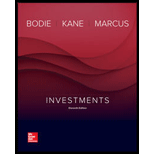
a.
To determine: The cost of restriction in terms of Sharpe’s measure
Introduction: The Sharpe ratio is used to measure the accumulated performance of an aggregate investment portfolio or an individual stock. It evaluates the performance of equity investment to the
a.
Answer to Problem 18PS
The cost of restriction in terms of Sharpe’s measure is in the cost
Explanation of Solution
Given Information:
Sharpe ratio is mostly used to measure the risk return. For this, first compute the expected
If the manager would not sell the securities he would consider only the stock A and C
| A | 1.6 | 3,364 | 0.00048 | 0.3352 |
| C | 3.4 | 3,600 | 0.00094 | 0.6648 |
| Total | 0.001420 | 1 |
The alpha of active portfolios,
The beta of active portfolio
So, the standard deviation of portfolio is,
The active risky portfolio,
The adjustment of beta,
The information ratio for the active portfolio,
The Sharpe ratio for the optimal portfolio,
Calculation of Beta,
The expected return,
The variance,
As, A = 2.8, the optimal position is calculated as,
So, the share per each asset is,
| BILLS | 1-0.5455 | 45.45% |
| MARKET | 0.5455x(1-0.0931) | 49.47% |
| A | 0.5455x (0.0931)x (0.3352) | 1.70% |
| C | 0.5455 x (0.0931)x (0.6648) | 3.38% |
| 100.00% |
b.
To determine: The utility loss to the investor in new complete portfolio
Introduction: The Sharpe ratio is used to measure the accumulated performance of an aggregate investment portfolio or an individual stock. It evaluates the performance of equity investment to the rate of return.
b.
Answer to Problem 18PS
The utility levels for the unconstrained, constrained and passive strategy are 10.40%, 10.23% and 10.16% respectively.
Explanation of Solution
Given Information:
Forecast returns, standard deviations and the beta values are given.
Sharpe ratio is mostly used to measure the risk return. For this, first compute the expected return on investment or individual stock, then subtract it from the risk free rate of return. Generally, when the ratio is greater than 1, it is considered as acceptable by the investors.
The variance and for passive strategy, the calculations are
| E ( R) | ||
| UNCONSRAINED STRATEGY | 4.79 | 170.95 |
| CONSTRAINED STRATEGY | 4.46 | 159.36 |
| PASSIVE STRATEGY | 4.32 | 154.31 |
By using the utility level formula,
Want to see more full solutions like this?
- What is the full form of "ATM"? a.Auto Teller Machine b.Automatic Teller Machine c.Automated Teller Machine d.Authorized Teller Machinearrow_forwardWhich of the following risks is indicated by the beta coefficient in Financial Management? a.Adjusted risk b.Non diversifiable risk c.Diversifiable risk d.None of thesearrow_forwardWhat is the full form of "EPS"? a.Exchange per Share b.Equity Private Selling c.Earnings per share d.Earning Preferred Stockarrow_forward
- What indicate the relationship between interest rate and reinvestment rate a.Positive b.Perfectly negative c.Zero d.Negativearrow_forwardWhat is the full form of "MMKT"? a.Middle Market b.Management Key Trading c.Money Market d.Mutual Market Tradingarrow_forwardYellow Ocean Paint is evaluating Project A. In year 3, Yellow Ocean Paint would have revenue of $688,000 and costs of $314,000 if it pursues Project A, and the firm would have revenue of $579,000 and costs of $219,000 if it does not pursue Project A. Depreciation taken by the firm in year 3 would be $216,000 if the firm pursues the project and $162,000 if the firm does not pursue the project. The tax rate is 20 percent. What is the operating cash flow for year 3 that Yellow Ocean Paint should use in its NPV analysis of Project A? Input instructions: Round your answer to the nearest dollar. 22,000 dollarsarrow_forward
- The excess of the present value of benefits over the present value of costs of a course of Action is called as: a.All of these b.Benefits c.Wealth d.Payoffarrow_forwardThe decisions relating to the use of profits or income of an entity or organization are known a.Any of these b.Dividend decisions c.Finance decisions d.Investment Decisionarrow_forwardWhat are the three interrelated areas of finance? (a) Financial markets, option and forwards (b) Banking, financial institutions and swap currency (c) Investment, Financial management and Financial market & Financial institution (d) All of abovearrow_forward
- The method that converts the amount of present cash into an amount of cash of equivalent value in future is: a.Budgeting b.Both a and b c.Discounting method d.Compounding methodarrow_forwardThe government finance which includes the principles and practices relating to the Procurement and management of funds for Central Government, and Local bodies is known as: a.Public Finance b.All of these c.Private Finance d.Business Financearrow_forwardwhat is financial ratios?arrow_forward
 Intermediate Financial Management (MindTap Course...FinanceISBN:9781337395083Author:Eugene F. Brigham, Phillip R. DavesPublisher:Cengage Learning
Intermediate Financial Management (MindTap Course...FinanceISBN:9781337395083Author:Eugene F. Brigham, Phillip R. DavesPublisher:Cengage Learning

